The Fascinating History Of Breakfast Soups And The Countries That Serve Them
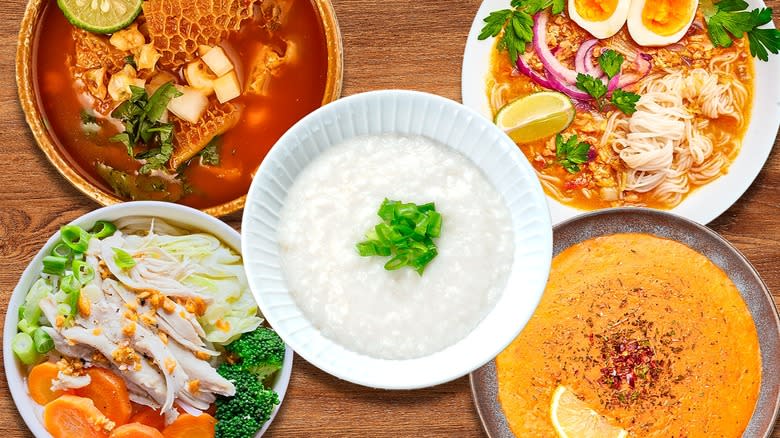
Soup is not typically considered a breakfast food in the US, but in many parts of the world, it's a big part of breakfast. This can be said for countries in Africa, South America, Asia, and Eastern Europe, making it apparent that it's a normal practice in pretty much every corner of the world except here. We usually eat soup when we're under the weather or need something to warm us up from the inside on a cold day, and these are the reasons why it makes for a great breakfast. Starting the day with something warm, filling, and packed with nutrients is an obvious choice. Plus, soup is usually easily digested, making it the perfect food to introduce to your digestive system in the morning and ease it into the day.
In many countries, breakfast soup is packed with vegetables, alliums, and spices that can wake and power you up for the day while providing your daily nutritional requirements early on. It's a great way to add some protein to your breakfast, which will give you extra energy and nutrients to keep you going throughout the day. Rather than having a heavy fry-up with eggs and bacon, which can often make you feel sluggish afterward, having a hot breakfast soup is one way of satisfying the need for flavor, protein, and nutrients while still feeling light enough to seize the day. For inspiration, here are some breakfast soups served around the world.
Read more: 20 Popular Canned Soups, Ranked Worst To Best
Chinese Congee
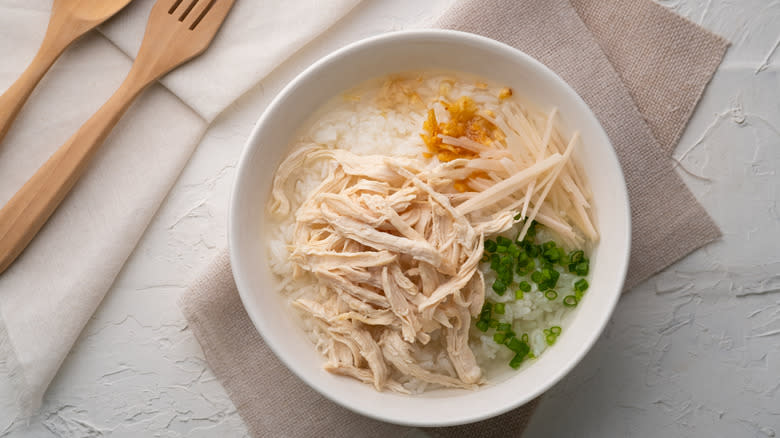
When thinking about breakfast soups from around the world, one of the most obvious dishes that comes to mind is congee. The traditional Chinese rice dish is as comforting as it is nutritious, making it an easy choice to start the day with. It's been prepared in China for centuries, with some suggesting it dates back to as early as 1,000 BC. Since then, it has spread all over Asia and even parts of Europe, like Portugal, where similar rice porridge dishes are eaten. The beauty of congee is in its simplicity, being not only relatively easy to make but also easy to digest. Many believe it's a healing porridge, so it's often made for someone who isn't feeling well. The main ingredient in congee is rice, which is soaked and then boiled until the grains break down, releasing starch and thickening the water.
In parts of China where rice is not grown as much, congee is made with other grains, like barley, wheat sorghum, millet, or corn. As a soup, it's a blank slate, which can be flavored with a variety of options, like garlic, ginger, chicken, scallions, eggs, vegetables, mushrooms, and spices. There's also sweet congee eaten in parts of China, where the rice is boiled with jujube dates, raisins, and rock sugar. Additionally, congee is an economical meal, as it adds "stretch" to a small amount of rice, making it a meal that many can afford to make.
Burmese Mohinga
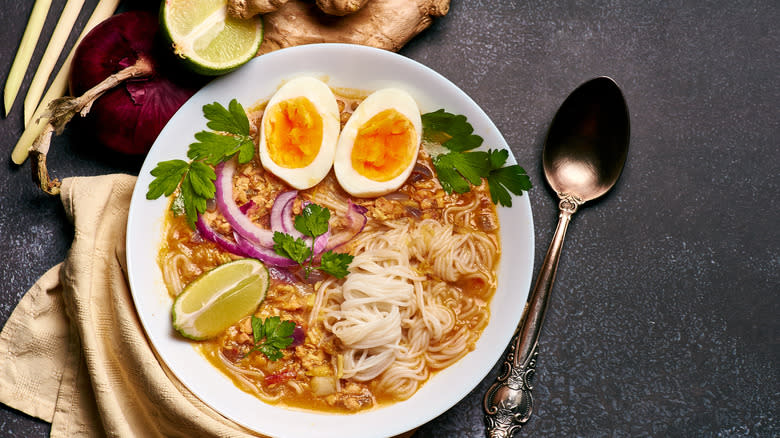
Mohinga is one of Myanmar's (previously Burma) national dishes, and this fragrant noodle soup is a beloved breakfast dish. The origins of this dish are unknown, but some have suggested that it has its roots in Chinese noodle soup dishes. The broth is fish-based, usually made with catfish, which is boiled in water with different alliums, like lemongrass and garlic, to extract all the umami and sweet seafood flavor. The noodles and other ingredients are cooked separately and then brought together at the end to build the dish. The broth also usually contains chickpea or rice flour, which helps thicken it, giving it a creamy appearance and allowing the flavorful broth to cling to the noodles.
The final soup is then garnished with a number of topping options, depending on the region and preference of the individual, like cilantro, lime or lemon juice, onions, eggs, or fishcakes. Although made with many ingredients, mohinga comes together as a tasty and nutritious soup, making it a great way to start the day. It is labor intensive and consists of many parts, so people usually prefer to eat it out rather than make it at home. If you want to attempt it, this Burmese breakfast stew recipe adapted from "Burma Superstar," by Desmond Tan and Kate Leahy, is a good place to start.
Scandinavian Blueberry Soup (Blåbärssoppa)
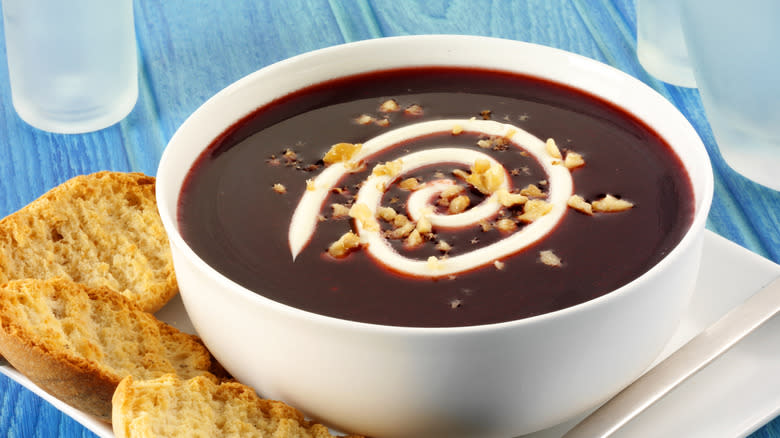
Most soups that are eaten for breakfast are savory -- actually, most soups eaten at any meal are. This isn't always the case, however, and blueberry soup is the Scandinavian breakfast staple that will surprise you. Similar to a compote, this soup features blueberries -- or more traditionally, bilberries (wild berries that grow in Scandinavian countries) -- cooked with water, cornstarch, and a sweetener like sugar or honey. This soup, called "blåbärssoppa," is sometimes eaten for breakfast or in various desserts. The history of how this dish came to be is unclear, but eating fruit soup is common in Scandinavian countries like Sweden, where bilberries grow abundantly and are said to cover about 20% percent of the land.
It's believed to be a big energy boost since the berries are full of vitamins and antioxidants. That's why it's often served to people who are about to head out for a ski and is one of the most eaten dishes during Vasaloppet, the world's biggest cross-country skiing event, which started in 1922 to commemorate Swedish independence. During this event, approximately 50,000 liters of blåbärssoppa are consumed.
This bright purple-blue mixture is served warm or cold, topped with things like yogurt or whipped cream, and you can make it your own by adding lemon zest or vanilla. To make this at home, you can use fresh or frozen blueberries, which are also nutrient-dense and just as delicious. Plus, you can make a big batch and freeze it for a future treat. All you have to do is warm it up in your saucepan and enjoy.
Colombian Changüa
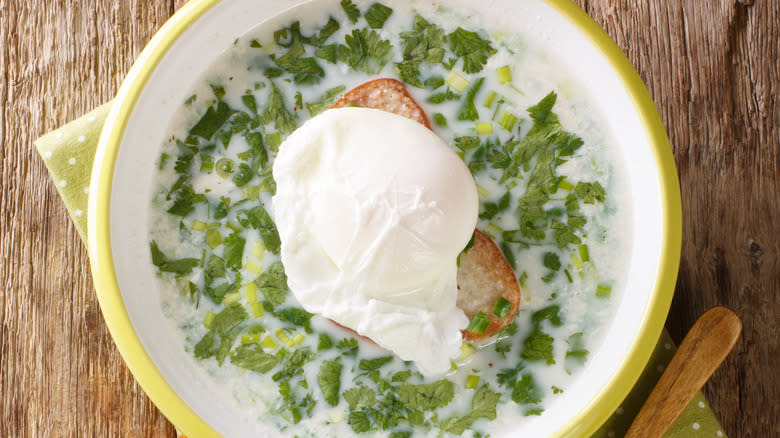
This Columbian dish hails from the central Andean region, where cities like Bogotá and Boyacá can reach altitudes of over 8,000 feet. It's a recipe that's been passed down through generations and originated from the Muisca tribe, or Chibcha, a community that's indigenous to the Central Andes. This mountainous region that experiences cold weather is known for warm and hearty meals like changüa. This eggy bread soup is a staple breakfast dish in Colombia and warms you up on a cold morning, getting you ready for the day. It's also recommended for hangovers or when people aren't feeling well since it's so comforting.
Changüa is typically cooked using water, milk, green onions, cilantro, and eggs. While some may use stock to make the broth, it's more commonly made with just milk, water, and seasoning. Eggs are dropped into the broth, along with the herbs, and the soup is ready within minutes. This dish also incorporates stale bread or arepas, which are either broken into the soup or placed in your serving bowl before the hot broth is ladled into it.
Japanese Miso Soup
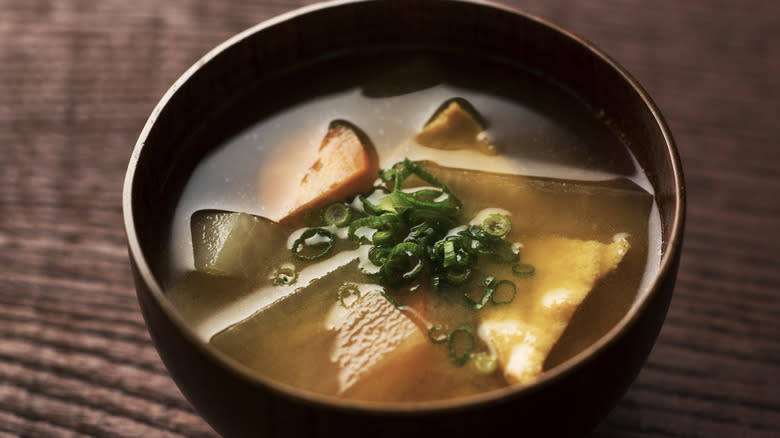
Perhaps one of the best-known breakfast soups around the world is Japanese miso soup. In truth, it's a soup that's eaten at any time of the day in Japan and is a ubiquitous dish at most Japanese restaurants. You may have found that it automatically comes with your order and been pleasantly surprised to have a complimentary soup. This is because it's considered an essential dish to any traditional Japanese meal. Miso has been around since at least the seventh century; however, it's debated whether its origins are Japanese or Chinese, or perhaps both. Miso soup, however, is a Japanese dish that has been eaten since the time of the early samurais during the Kamakura period (1185–1333).
The soup is made from just a few ingredients, like miso paste, tofu, and seaweed, with a broth called dashi, usually made with dried bonito flakes, giving it a deep umami taste. It sometimes includes other vegetables, like green onions or mushrooms. It can also be filled with meat and more vegetables, making it a main dish, usually eaten with plain rice. It's packed full of nutrients and flavor and is a great way to start a morning. The best thing about it is that if you have miso paste, bonito flakes, and tofu, it comes together within minutes with some boiling water.
Tunisian Lablabi
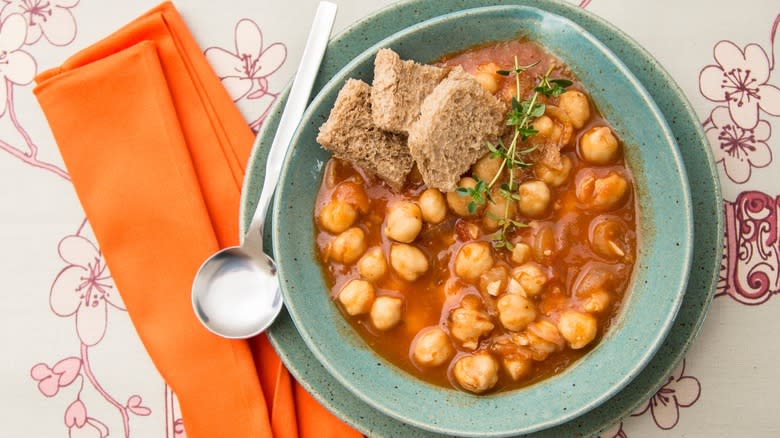
Lablabi is one of the markers of Tunisian cuisine and a popular street food for breakfast. While Tunisian cuisine is relatively lesser known compared to that of other North African countries, Tunisia has a rich culinary culture with distinct flavors and ingredients. Lablabi, being one of the national dishes, holds many of the flavors and ingredients that characterize Tunisian cuisine, like fresh herbs, spices, olive oil, lemon juice, and harissa paste. How this dish came to be is unclear, but it's believed to hail from the time of the Ottoman Empire's occupation of Tunisia, with the name "lablabi" coming from the Turkish word for roasted chickpeas.
This hearty chickpea soup or stew is the ultimate comfort food, especially on colder days. It's made from simple ingredients, but it packs a punch. Chickpeas are cooked in spiced broth until they're soft and tender. Each bowl starts with a base of bread that is doused with hot broth, making lablabi a great way to use leftover or stale bread. After the broth, a generous amount of chickpeas are ladled in, followed by several toppings that you can customize. In addition to harissa, olive oil, and lemon juice, the usual toppings involve pickled chiles, tuna, and a poached egg. These ingredients are then mixed together to make a steaming bowl of tasty soup.
Korean Egg-Drop Soup (Gyeran Guk)
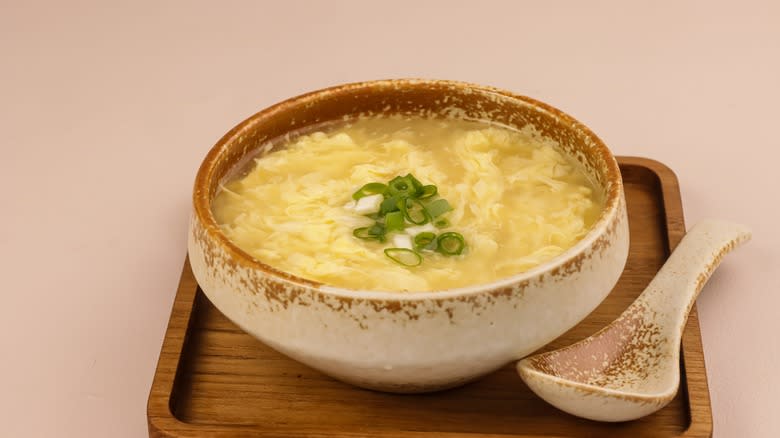
Korean cuisine is known for a number of delicious soups and broth-based dishes, many of which are eaten for breakfast. In fact, Korean breakfast foods are hardly differentiated from lunch or dinner, and most dishes, like stews, soup, rice, and banchan (the numerous side dishes served with meals), can be eaten at breakfast. One breakfast staple is gyeran guk, an egg-drop soup that's as quick to make as it is nourishing. It's also a popular dish with children, as it's mild in flavor and not too spicy. The history of this soup is unclear; however, it possibly originates from Chinese egg-drop soup, a dish that was invented by imperial Cantonese chefs and then spread throughout China.
The base of the broth for gyeran guk is a stock made from dried anchovy or dried kelp, which is one of the key differences between it and Chinese egg-drop soup, which uses chicken stock. The stock is simmered on the stove with soy sauce and salt until the water starts to bubble as it boils. The heat is then reduced, and a beaten egg is gently dropped into the broth. At first, the egg is left to settle, and then it's stirred in order to break it up until it's fully cooked. The soup is then served with white rice and a drizzle of sesame oil, giving it a light and pleasant nuttiness.
Singaporean Bak Kut Teh
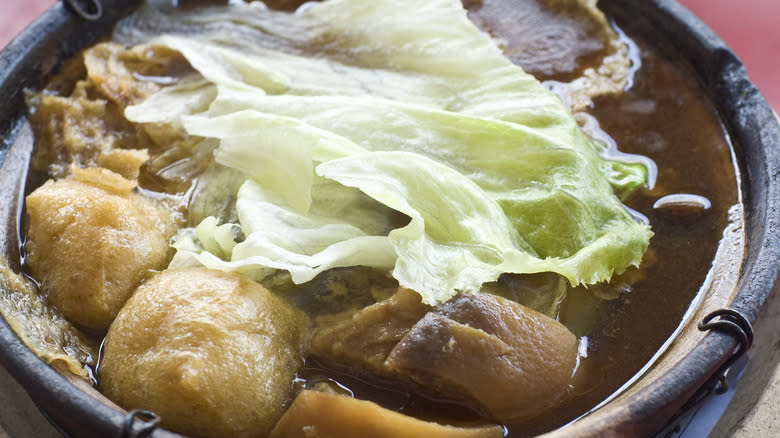
Bak kut teh is a dish that's beloved in both Singapore and Malaysia. While simple in appearance, it's a complex dish to make. That's why people hardly ever cook it at home, but restaurants and cafes around the city-state of Singapore serve it to queues of people on their way to work in the morning. Translated as "pork bone tea," this soup is made from cuts of pork such as ribs and belly and steeped with medicinal herbs. Its history isn't fully known or agreed on, but some sources suggest it was introduced to the region by Chinese immigrants who sought a recipe that would help them get used to the tropical weather of Singapore. It gained widespread popularity during the 1960s as an affordable meal that could power up the laborers who worked at the harbor.
There are differing regional styles of broth for bak kut teh. The Teochew style runs clear and has an overarching flavor of white pepper, while the Hoklo style uses soy sauce and is distinguished by a darker-colored broth, and the Cantonese style uses medicinal herbs. It's a dish that's harder to come by stateside since cuisine from Malaysia and Singapore is not as widespread, but if you're in NYC, you can try some at Nyonya.
Danish Buttermilk Soup
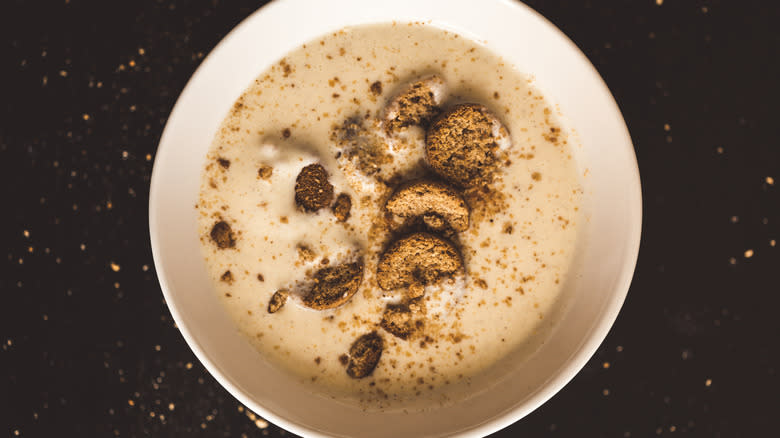
Koldskål, also known as Danish buttermilk soup, is a sweet, creamy soup that's enjoyed in Denmark for breakfast. Koldskål translates to English as "cold bowl," describing why it's particularly enjoyed in the summer. This cold buttermilk concoction is tangy and refreshing when eaten chilled and is said to be a summer staple. Its origins are attributed to the time when commercial buttermilk production began in Denmark, in the early 1900s. Now, many people buy cartons of premade koldskål from the grocery store, where it's widely available. Reportedly, premade koldskål has been available since 1979, and its sales tend to increase the warmer the weather is.
In the summer, it's eaten like cereal poured in a bowl with broken kammerjunkere biscuits, which usually have a lemon or cardamom flavor. If you're wondering how to make Danish buttermilk soup, you'll be happy to know that it's incredibly easy, and some Danes prefer to make their own. Some pasteurized egg yolks are whipped with sugar and vanilla and then mixed with buttermilk. Some variations include yogurt or even oats. If you don't have any kammerjunkere biscuits, some fresh strawberries go great with it.
Turkish Ezogelin çorbası
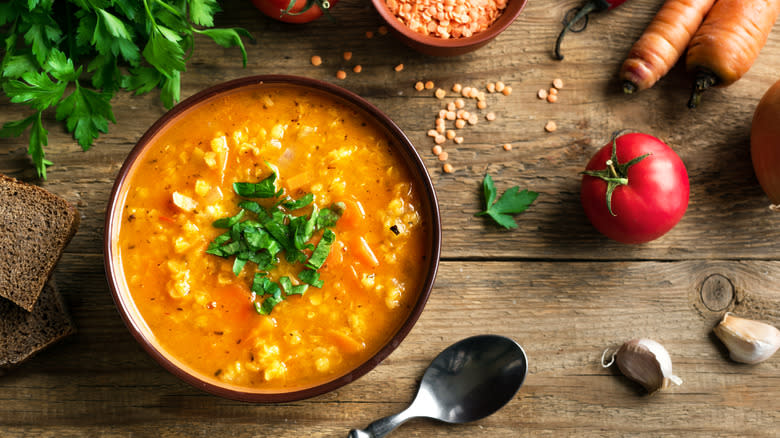
Lentil soup is a hit in many cultures, each with its own take on it. In Turkey, a lentil soup called ezogelin çorbası is the star. Eaten for breakfast or at any other time of the day, this beloved soup is ubiquitous, and one you can find at most home-style restaurants. This soup was supposedly named after a woman named Ezo from a village called Dokuzyol in the early 1900s. The tragic legend goes that Ezo was incredibly beautiful and sought after yet couldn't find love and happiness through her marriages. After a bad first marriage, her second marriage took her to Syria, where she had to deal with a difficult mother-in-law. It is said she created this soup as a way of coping with her homesickness.
Ezo's tale lives on through folklore and popular memory, as well as through the soup named after her. The continuing tradition in Turkey is that ezogolin is served to brides to sustain them through the uncertainty of what the future holds. While the soup's origins may be sad, the dish is anything but. This tomato-based soup is often made using red lentils, paprika, bulgur wheat, and dried mint, and it is as flavorful as it is filling and nutritious.
Mexican American Menudo
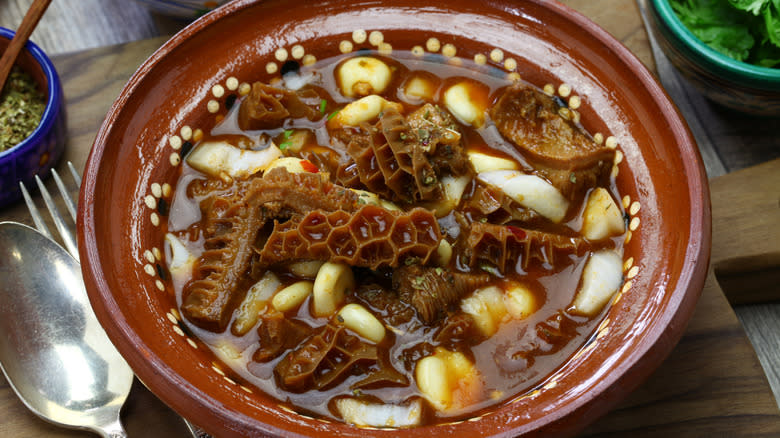
One of the commonalities among breakfast soups around the world is that they are often said to be the best cure for a hangover. This rings true for menudo, a spicy tripe and hominy soup that many Mexican Americans swear by. Menudo is a favorite breakfast choice after a night of drinking for Mexican Americans of all ages living in Texas, New Mexico, California, and Arizona. Enrique Ochoa, a professor of history and Latin American studies, attributes the origins of this dish to the 1930s and 1940s when migrant workers from different parts of Mexico started settling in cities like San Antonio and Los Angeles, exchanging recipes (via Vice).
As menudo is laborious and time-intensive to cook, it's usually made on weekends or for gatherings, cooked in large amounts. It quickly became the main dish served at celebrations and get-togethers since it uses affordable cuts of meat, like stomach, and is a crowd favorite. This soup isn't always packed with chiles, but depending on the preference of the cook, it can be known to pack a punch. Either way, it'll be sure to give you the waking up you need after a night out.
Vietnamese Phở
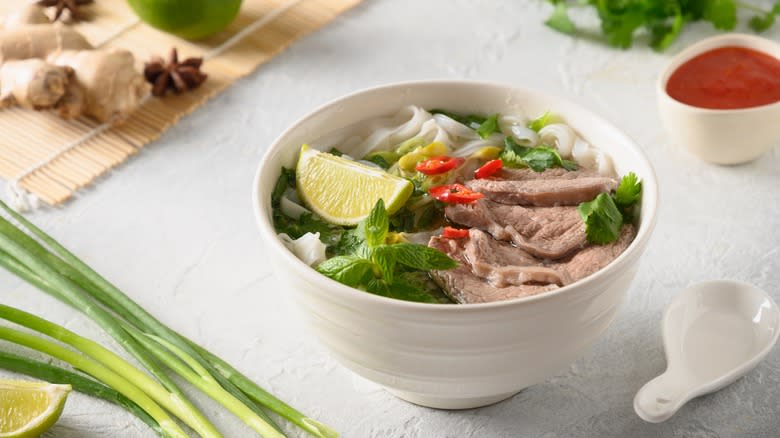
Vietnamese cuisine is loved all over the world, and phở has become one of the standout dishes for many people being introduced to it. This steaming noodle soup is a crowd-pleaser, because who can resist its savory and nutritious comforting goodness, especially on a cold day? In Vietnam, where phở is eaten for breakfast, phở vendors begin prepping the dish in the early hours in anticipation of the morning rush. Phở became popular during the time of French colonialism in Vietnam in the late 1800s. When the French introduced beef to the country, the leftover beef bones became a useful ingredient to make broth with -- hence, the beginning of the beef bone-based broth that phở is known for.
The broth is added to a bowl of rice noodles, and additions like fresh herbs, sprouts, and hoisin sauce, among other things, are often provided with the bowl for each person to customize their soup. If you're a newcomer to phở, be prepared for the beef to be added raw to your bowl, and it will be cooked when the hot broth is added. That's why it's important to slice beef really thin when making phở at home. You'll see the magic happen in front of your eyes, and the thinness of the beef will make it tender to the bite.
Read the original article on Tasting Table


